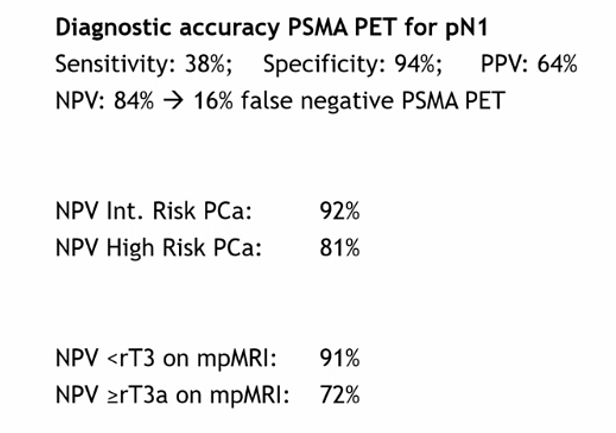Data from the ProPSMA trial, A prospective randomised multi-centre study of the impact of Ga-68 PSMA-PET/CT imaging for staging high-risk prostate cancer prior to curative-intent surgery (proPSMA), which was published this spring1 and presented at EAU 2020, demonstrated that PSMA PET/CT outperforms traditional pre-treatment staging (with CT scan and bone scan) with respect to the identification of either pelvic nodal or distant metastatic disease with an accuracy of 92% compared to 65% for conventional imaging. Notably, the AUC, specificity, and sensitivity were higher for PSMA PET/CT when assessing any metastatic disease, pelvic nodal disease, and distant metastatic disease.
In this presentation, Dr. Meijer sought to examine whether a negative PSMA PET/CT could allow for the omission of extended pelvic lymph node dissection.
To do so, the authors examined 435 patients who underwent pre-operative PSMA PET/CT prior to robot-assisted radical prostatectomy and pelvic lymph node dissection. The author considered pre-operative characteristics including clinical tumor stage, serum PSA level, and biopsy Gleason grade group in addition to pathological parameters including the histopathologic lymph node status (pN0 vs pN1).
The authors assessed the diagnostic accuracy of PSMA PET/CT for the identification of nodal disease across different prognostic groups.
Among 435 men examined, PSMA PET/CT was suggestive of pelvic lymph node metastasis in 56 (13%). Following surgical excision, pathological evidence of nodal involvement was found in 94 patients (22%). Thus, the overall sensitivity, specificity, positive predictive value, and negative predictive value (NPV) were 38.3%, 94.1%, 64.3%, and 84.7%, respectively.

When stratified according to tumor risk groups, the NPV of PSMA PET/CT was 92% in patients with the intermediate-risk disease and 82% in patients with high-risk disease, likely driven by differences in the prevalence of nodal involvement in these two populations. However, the NPV was more similar when subgroups were defined based on grade group: 85%, 88%, and 83% respectively among patients with ISUP 1-2, 3, and 4-5 disease.
Among patients with ISUP 3 and intermediate-risk disease, the NPV was 94%.
Taken together, these authors conclude that their data does not suggest that PSMA PET/CT has a sufficiently robust negative predictive value to exclude lymph node involvement to allow for the omission of lymphadenectomy at the time of radical prostatectomy.
Presented by: Dennie Meijer, MD, PhD Candidate, Arts-onderzoeker Urologie bij VUmc, Amsterdam, The Netherlands
Written by: Christopher J.D. Wallis, Urologic Oncology Fellow, Vanderbilt University Medical Center, Contact: @WallisCJD on Twitter at the 12th European Multidisciplinary Congress on Urological Cancers (EMUC) (#EMUC20 ), November 13th - 14th, 2020
References:
1. Hofman, Michael S., Nathan Lawrentschuk, Roslyn J. Francis, Colin Tang, Ian Vela, Paul Thomas, Natalie Rutherford et al. "Prostate-specific membrane antigen PET-CT in patients with high-risk prostate cancer before curative-intent surgery or radiotherapy (proPSMA): a prospective, randomised, multi-centre study." The Lancet (2020).


